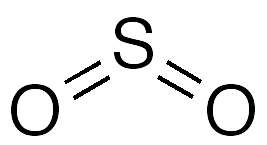What molecule am I?


Sulfur dioxide (SO2) is a pungent, toxic gas that is the primary product of burning elemental sulfur. It exists widely in nature, mostly from volcanic activity and burning fossil fuels. It is found elsewhere in the solar system, as a gas in the atmospheres of Venus and Jupiter’s moon Io and as an ice on the other Galilean moons.
The major use of SO2 is in the manufacture of sulfuric acid (H2SO4), the most-produced chemical worldwide. Elemental sulfur and oxygen react to form SO2, which is catalytically oxidized with additional oxygen to make sulfur trioxide (SO3). The SO3 is mixed with existing H2SO4 to produce oleum (fuming sulfuric acid), which is added to water in a strongly exothermic process to make concentrated H2SO4. This is known as the contact process; it dates to an 1831 patent by British inventor Peregrine Phillips.
In chemical laboratories, it has multiple functions, including as a reducing agent, as a reagent in sulfonylation reactions, and as a low-temperature solvent. SO2 is also used to preserve dried fruits such as raisins and prunes and to prevent spoilage in wine.
The hazard information table shows that SO2 is pretty nasty stuff; but, in addition to its value as a chemical, it has another positive side: Volcanoes that emit the gas can have a beneficial effect on climate change. When SO2 spews into the stratosphere, it reacts photochemically with oxygen to form H2SO4 aerosols, which in turn reflect solar radiation and cool the atmosphere. But, as might be expected, even this has a downside because SO2 and H2SO4 contribute to acid rain.
Sulfur dioxide hazard information*
| Hazard class** | GHS code and hazard statement | |
|---|---|---|
| Gases under pressure, liquefied gas | H280—Contains gas under pressure; may explode if heated | |
| Skin corrosion/irritation, category 1B | H314—Causes severe skin burns and eye damage | |
| Serious eye damage/eye irritation, category 1 | H318—Causes serious eye damage | |
| Acute toxicity, inhalation, category 3 | H331—Toxic if inhaled | |
*Most commonly cited hazard classes are listed. Other safety data sheets mention additional hazards.
**Globally Harmonized System (GHS) of Classification and Labeling of Chemicals.Explanation of pictograms.
Molecule in the News
Formaldehyde1, the simplest aldehyde and an important industrial and laboratory chemical, was the Molecule of the Week for May 29, 2006. Its many commercial uses include the production of resins used as adhesives in building materials, carpeting, and insulation materials.
But formaldehyde has a dark side. Small amounts of it can emanate from residences, work environments, and manufacturing plants, causing medical problems ranging from eye irritation to respiratory difficulties to nervous system disorders to various cancers. Many of its uses have been restricted or banned.
Although the National Toxicology Program designated formaldehyde as a human carcinogen in 2011, the US Environmental Protection Agency has yet to label it as such. In 2022, EPA commissioned the US National Academy of Sciences to review a draft risk assessment that formaldehyde is a human carcinogen; and this month, NAS reported that it concurred with EPA’s findings. Almost immediately, the American Chemistry Council, a trade association, challenged the assessment, saying that EPA’s and NAS’s scientific methods were flawed. Much is at stake because almost 1 million workers make formaldehyde-containing products that generate more than $500 billion in US sales.
1. CAS Reg. No. 50-00-0.
Molecule in the News
MOTW highlights molecules that appear in major news outlets. See this week's edition below.
This molecule was suggested by a reader. We present almost all of the molecules suggested by our readers. If you have a molecule you would like us to consider, please send us a message. And thank you for your interest in Molecule of the Week! —Ed.
Sulfur dioxide fast facts
| CAS Reg. No. | 7446-09-5 |
| SciFinder nomenclature | Sulfur dioxide |
| Empirical formula | O2S |
| Molar mass | 64.06 g/mol |
| Appearance | Colorless gas |
| Boiling point | –10 °C |
| Water solubility | 110 g/L @ 20 °Ca |
a. From solubility chart in a 2022 article by Junfu Yuan* and Meizhou Xu at Jiangsu Maritime Institute and Bureau (Nanjing, China).

Learn more about this molecule from CAS, the most authoritative and comprehensive source for chemical information.
Molecule of the Week needs your suggestions!
If your favorite molecule is not in our archive, please send us a message. The molecule can be notable for its current or historical importance or for any quirky reason. Thank you!
Stay Ahead of the Chemistry Curve
Learn how ACS can help you stay ahead in the world of chemistry.

